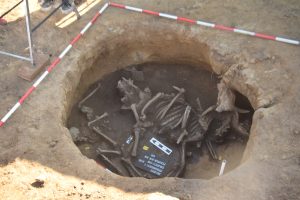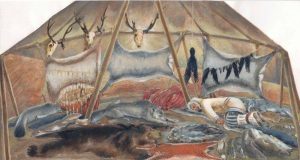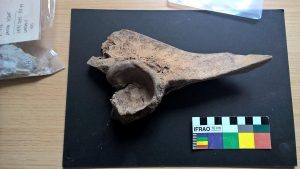Coexistence of humans and animals in history
Coexistence of humans and animals in history
Agelong interaction of humans and animals must have naturally found its reflection in archaeological record since the earliest periods of the human history. At the beginning it concerned especially hunted game, during the Upper Palaeolithic period first domesticated dogs appeared and in the Neolithic other animal species, such as goats, sheep, pigs and bovids were domesticated. These animals were, of course, domesticated for meat and other products (milk, wool, hides etc.), but also for sport, entertainment and as pets (e.g., cats and horses). Significant part of animal remains appears in archaeological contexts indicating signs of adoration, cult or rituals. In these cases, the animal remains present the main part of the archaeological context or sometimes they appear together with human remains and they give the finding a mysterious sense.
This mutual interaction of humans and animals will be in a frame of this project analysed in various archaeological contexts (settlements, graveyards, ritual sites) in usual (settlement kitchen refuse) as well as in unusual (ritual animal graves, humans buried together with animals, religious offerings) finding situations. It will be interesting to compare particular faunal species (wild as well as domesticated) with a combination of contexts, in which they appear (e. g. bovids as useful draught animals and their ritual graves, animal bones as a part of grave offerings, animals at ritual sites, a dog as a companion of humans, pet, warden, hunter, protector of herds and its funeral context in association with human bones, wild animals and their role in substitutive graves etc.). A group of problems connected with the human-animal interaction (animals in settlement, funeral and ritual finding context) will be in a centre of our attention.
Animal bones were found in some Palaeolithic and Mesolithic graves and since the Neolithic period they have become regular part of a funeral contexts (funeral feasts and rituals), usually in a form of a meaty meal accompanying a deceased individual during his journey in the life after death. Spiritual aspect of animal bones in human graves (such as bones of birds as sacred animals carrying the souls of deceased people to the afterlife) is also interesting. Bones of certain animal species present in the human graves could be interpreted, rather than as meaty offerings, as a ritual deposit of animal companions of deceased people. Various offerings or ritual pits (or ritual areas with religious and ideological function), where graves containing human and animal bones can be often found, represent another interesting category of finding context.
There is a question, if it is possible with a use of modern scientific analyses to prove a gender connection between human and animal remains found in graves. Is it true that most animal bones (especially in the case of chieftain graves) in the men graves came from male individuals and the other way around that most animal bones in the women graves (including so called graves of the Amazons – female graves with male goods) came from female individuals? Did the prehistoric people maintain the gender differentiation in a case of this kind of a grave goods or not? Was there a selection of animal species regarding gender and age of buried individuals? Is it possible to prove relations such as adult human – adult animal, child – young animal in the human graves? And is it possible to apply this relation also to the bone/antler artefacts (such as to boar tusks and to the artefacts made from them)? Was the gender relation kept also in the case of so-called substitutional graves (e. g. when an animal with grave goods was deposited in a grave instead of deceased human)? What is a composition (species, sex, age) and meaning of animal burials deposited in graves as well as in settlement features? What is a role of a horse deposited as a companion of deceased people at the beginning of its existence as a domesticated animal? Are there any clear gender binds between humans and animals also in the case of ritual/religious archaeological finds? What do such buried individuals have in common and how is it possible to interpret such findings?
These and other similar research questions will be answered in a frame of this project on a base of selected graveyards or sites excavated during previous excavations. For these purposes, already published data can be used and new measurements and analyses will be also performed. Selected graveyards and other sites from different parts of Europe which fulfil the conditions of the project (e. g. gender differentiation, rich graves, animal graves, human graves containing animal bones, ritual features with animal offerings etc.), will present a material base of the project. Among these sites we would like to choose appropriate findings (e. g. especially funeral and settlement archaeological contexts), where we could analyse amount and composition of animal remains, their location in graves, manner of their deposition (in a vessel, in a pit etc.), completeness of animal skeletons, selection of meat, function of animal material in funeral contexts, number, sex and age of deposited individuals etc. We would be interested also in the origin of animals (if it will be possible to determine). For this purpose, we presume an application of the archaic animal DNA analyses, stable isotopes analyses and absolute dating methods for dating of bones and archaeological contexts. In a case of bone and antler artefacts, if possible, also technological, typological and use-wear analyses will be applied.
A relationship between humans and animals has been a part of the history since the beginnings of the human kind. At first, animals were used primarily as a source of a meat and after their domestication, selected animal species have become companions of humans in their everyday life. They were used for example as draught/transport animals or as a source of meat, milk and raw materials (hides, bones, horns etc.), but they have also become a part of human afterlife as companions and pets (dogs, horses, roe deer?) and also a part of funeral rituals, for example as symbolic grave good (food for a journey to the afterlife). Animals have their specific place also in a structure of cult and ritual places and sanctuaries (is there any evidence of real offerings?). Is it possible to distinguish any strong binds between buried humans and animals (in a symbolic level), which caused that these animals could have been somehow selected? And if this is the case, what were the conditions of this selection? Was it for example social status, gender or age of animals and humans?
Animal bones and skeletons in all archaeological contexts have been up to date in the category of offerings (grave goods) with just marginal attention of archaeologists, which often resulted just in a determination of particular animal species found in the osteological material. The aim of this project is to emphasize this kind of findings together with its relation to (buried) humans. With a help of modern scientific analyses, we would like to answer the research questions concerning sense, purpose, function and meaning of animal offerings, ritual slaughtering and jointing of animals in a sphere of funeral as well as ritual practices.

A burial of a bovid, a pig and three children in a storage pit at the Přerov-Předmostí site (Bronze Age). Excavation of the Archaeological Centre in Olomouc. Photo by Vít Hadrava.

A reconstruction of the Palaeolithic burial Dolní Věstonice 16. Drawing by Jiří Brenner.

A fragment of bovid pelvis (Bos taurus) with an inflammation of a joint. Photo by Miriam Nývltová Fišáková.





